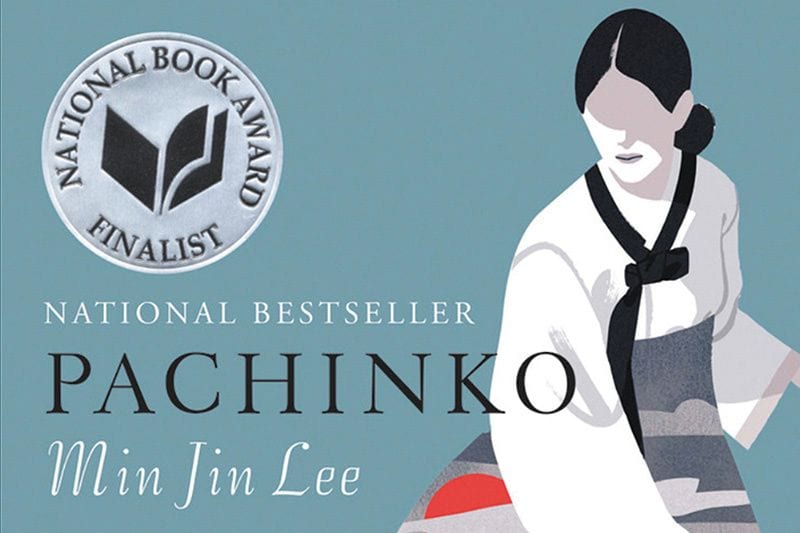
The obvious difficulty with choosing to tell the 20th-century story of immigrant life in a foreign land can be seen in that very choice of article. Is this the life of these people, or is it simply a series of lives, a carefully calibrated sample of equal representations, a sanitized and equally balanced example of demographics within a population whose end result is always the perfect mix of entertainment and accurate history? What do we want from our historical, literary novels?
Min Jin Lee‘s Pachinko is a remarkably textured, assured, and confident take on the life of Korean immigrants living in Japan from 1910 through today. The effects of poverty, institutionalized racism, domestic abuse, suicide, and the sometimes alarming accumulation of wealth are illuminated through the story of 28-year-old Hoonie, “born with a cleft palate and a twisted foot.” He enters into an arranged marriage with 15-year-old Yangjin, and they eventually bond over a mutual love for their daughter, Sunja. By the time she is 13, Sunja’s father dies of tuberculosis, and life thereafter is all about trying to cope. She and her mother live in a rooming house with colorful characters and charm to spare.
At this point, we see and embrace a fully realized Sunja. She’s seduced and impregnated by Koh Hansu, a slick Yakuza with everything to spare to save time for Sunja and their son, Noa. Baek Isak, a kindly pastor with no real alternatives, befriends and marries Sunja. He considers what she’s getting in this matrimonial union:
“…She’s not getting a good bargain. I may fall ill again soon. But I’d try to be a decent husband. And I would love the child, He would be mine, too.’ “
They make their way to Japan. “‘Every Korean must be on his best behavior over there,'” we learn. “‘They think so little of us already.'” There’s a sense of moral honor in all the varied characters we meet in Pachinko. People are simply trying to get by, to raise their families, and maintain a sense of dignity in trying times. Wives die, children maintain respect for their parents, and in spite of his unwillingness to divorce his wife, Koh Hansu maintains an allegiance to Sunja, if only monetarily. Sunja’s greatest connections seem to be with her new sister-in-law:
“She loved spending the day with Kyunghee, whom she called Sister. After two brief months, they found themselves enjoying a close friendship-an unexpected gift for two women who’d neither expected nor asked for much happiness.”
Sunja and Baek Isak have a son of their own, Mozasu. Noa, the first son, eventually becomes estranged from his mother after he learns the true identity of his father. His ending is tragic. Mozasu becomes a businessman in the field of Pachinko, the Japanese arcade game. He’s the antithesis of his brother’s intellectual accomplishments and aspirations. It’s Noa before learning the truth and missing the imprisoned man he thought was his father, who is haunted by the past that, in retrospect, was never really understandable:
“The boy tried to remember his father’s face, but couldn’t… The big secret that he kept from his mother, aunt, and even his beloved uncle was that Noa did not believe in God anymore.”
Lee balances this richly textured tale of Sunja and the family she created with the regular scenes of poverty, disrespect, and inhumane conditions endured by Koreans in Japan during WWII. Lee’s clear-headed style and control over this story reflect the mindset of her characters. Their mission is to raise their families and maintain a sense of dignity despite the obstacles. Once they are able to see that survival is theirs for the taking, they will begin to work on human rights issues.
It’s not lost on the reader that while the pool hall parlor game Pachinko is the family business, it can also be seen as a metaphor for the lives of the characters themselves. They will be shot out into the world at birth and bounced against one side of the game and hit another. There are bumpers, hidden corners, and angles where it seems they’ll get stuck (but won’t), but there will be no escaping the fate that sends them plunging to a definite conclusion based on race, economics, and a variety of other factors. This was probably the best structure in which to place these characters.
How do we take Hansu? He’s always financially there, and he’s always aware of Sunja and the boys, but he’s a brutal abuser who will act only in his best interests. Lee wants us to embrace Sunja and the boys but it takes time. This is a long, textured novel written with the view of a wide-angled landscape that evokes the work of John Galsworthy and Charles Dickens. Perhaps it can also be seen in the way Noa chooses to perceive himself:
“If he had an embarrassing wish, it was this: He would be a European from a long time ago. He didn’t want to be a king or a general… If anything, he wanted a very simple life filled with nature, books, and perhaps a few children.”
The women survive by the end of Pachinko, and we see Sunja in the final graveyard scene understanding that the past will always be with her:
“…The people you loved, they were always there with you…”
Pachinko is a beautiful, haunting, at times, stunning epic that earns our attention on every page. It’s compulsively readable. Lee respects her characters and understands we need to feel the same way. By carefully illustrating their lives through a meticulous tapestry of scenes and images that, when combined, are staggering in their ability to invoke our empathy, Lee has created in Pachinko a novel whose importance, beauty, and power to speak of the universal human condition will not soon be forgotten.


![Call for Papers: All Things Reconsidered [MUSIC] May-August 2024](https://www.popmatters.com/wp-content/uploads/2024/04/all-things-reconsidered-call-music-may-2024-720x380.jpg)



